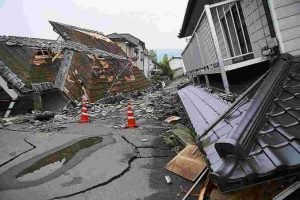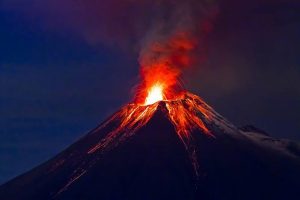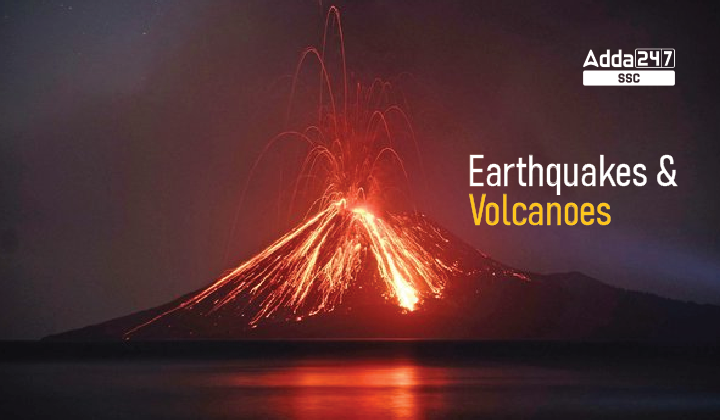Earthquakes and Volcanoes
Earthquakes and Volcanoes are natural phenomena and are capable of creating very high impact in a very short interval. The earth’s crust floats over the molten magma layer of the mantle. The sudden movement of the crust can result in some of the most significant natural disasters. An earthquake is defined as any sudden shaking of the ground due to seismic waves passing through Earth’s crust. A volcano is a crack in the earth’s crust that allows the eruption of lava, volcanic ash, and gases. The majority of Earthquakes and Volcanoes occur in the Ring of Fire. The Ring of Fire, also referred to as the Circum-Pacific Belt, is a path along the Pacific Ocean characterized by active volcanoes and frequent earthquakes.
Causes of Earthquakes
The majority of earthquakes are usually caused by sudden movements of plates along the fault lines. These plates are constantly moving due to thermal convective currents. Stress stored due to bending, faulting, or other physical processes is released as kinetic energy through weak zones on the surface.
The sub-surface area along a fault plane, where the seismic waves are originated, is called the focus or hypocenter of an earthquake. And the area at the surface directly above the focus is the epicenter.
Sudden and quick release of energy causes vibrations in the earth crust, thus resulting in Earthquake. Earthquake waves propagate outwards from the epicenter. The most damage occurs closest to the epicenter, and the severity of the earthquake weakens as it moves away from it.
Seismic Waves
Seismic Waves are the waves of energy created at the time and position of the earthquake. They travel through the earth and we can record their intensity by using a seismograph. There are two types of seismic waves i.e. Body waves and surface waves.
- Body waves are created at the point of origin of the earthquake and travel in all directions inside the earth.
- Surface waves are created when the body waves reach the earth’s surface. These waves are more powerful on the surface and cause more damage and destruction.
- Body waves can further be categorized as P and S waves. P waves can travel through solid, liquid and gaseous material and S waves can only travel through solid material. Analyzing these waves has helped geologists study the interior structure of the earth.
Causes Of Volcano
A volcano occurs when molten magma from the earth’s interior erupts through vents and cracks in the crust, accompanied by steam, gases such as hydrogen sulphide, sulphur dioxide, hydrogen chloride, carbon dioxide, etc. and pyroclastic material (cloud of ash, lava fragments carried through the air, and vapour).
The chemical composition and viscosity of the lava determines the shape and size of the Volcano.
Types of Volcanoes
Volcanoes are of many types which are categorized based on their nature of eruption and their forms on the surface. These different types of volcanoes are found in different parts of the world and have major contributions to developing the type of land, flora and fauna of the area. Let us look at the different types of volcanoes found around the world.
- Shield Volcanoes – These types of volcanoes are mainly made up of Basalt. They explode only when water enters the vents and interacts with the lava.
- Caldera – Such volcanoes are the most explosive. The name caldera comes from the shape they take after the explosion.
- Composite Volcanoes – Volcanoes of this type produce colder lava accompanied by large amounts of pyroclastic material and ashes. These are mainly found in the Ring of Fire stretch in the Pacific Ocean.
- Flood Basalt Provinces – They get this name from the fact that they discharge large amounts of basalt that flows fast and covers large distances.
- Mid-Ocean Ridge Volcanoes – These volcanoes cover a large area 70 thousand Kilometers stretching across the oceans of the world.
Earthquakes and Volcanoes Photos
You can see pictures of Earthquake and Volcanoes given below:


Some Facts for Exams
- The molten rocks inside the earth are called Magma and when this magma comes to the surface through the volcanoes, it is called Lava.
- Underwater earthquakes are the major factor behind disastrous events such as Tsunamis.
- A seismograph is a device that is used to detect earthquakes and the Richter Scale is a measure of the strength of an earthquake.
- The origin point of an earthquake inside the earth is called the Focus (or Hypocenter) and the point directly above the Focus on the surface where the seismic waves make the first contact is called the Epicenter.
Conclusion
Earthquakes and volcanoes are disastrous events that create widespread devastation on the earth’s surface. They occur due to the movement of plates and Earth’s internal stored energy. The occurrence of earthquakes has increased in recent times due to a sudden rise in developmental activities in the past decade. Countries around the world are victims of such intense natural disasters and have put in place some rules and regulations in order to minimize the loss of life and property.




 Upcoming Government Exams, Complete Govt...
Upcoming Government Exams, Complete Govt...
 Govt Jobs 2025, Latest Upcoming Governme...
Govt Jobs 2025, Latest Upcoming Governme...
 SSC Exam Calendar 2025–26 Out, Check All...
SSC Exam Calendar 2025–26 Out, Check All...









